
For most of us, the first time hearing about the theremin went something like this…
You’re watching an old Led Zeppelin video and you see Jimmy Page waving his hands around in the air like some evil sorcerer.
And then you hear the crazy sounds apparently coming from nowhere. And then you noticed that tiny little box with the antenna…
Then suddenly…all the confusing details make sense.
And after a little bit of online investigating, you finally discover that it’s actually called…a theremin!
Then you do a bit more research and arrive here this ultimate guide, where today, you’ll get a crash-course on this little-known instrument.
First up…
The Origins of the Theremin
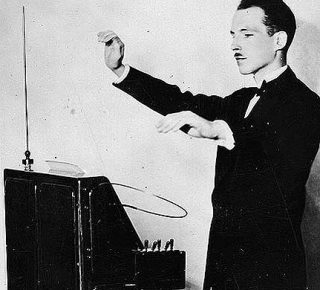
Back in 1920, Russian physicist Leon Theremin built the first ever theremin.
According to many sources, it’s credited as the first electronic instrument ever invented.
Soon after, he brought his invention out West in hopes of making it popular in America.
But for many years, his efforts were mostly in vain, and the theremin went unplayed by all but a select few musicians…
Until the 1950’s when Robert Moog began building his own theremin’s and the instrument gained some degree of popularity in the decades following.
In 1994, the film Theremin: An Electronic Odyssey was released, and the instrument gained perhaps it’s highest level of popularity to date among musicians and filmmakers.
Up next…
What Kinds of Sounds Can a Theremin Make?
If it’s been a while since you’ve seen a theremin in action, here’s a quick video of Jimmy Page doing his thing, with Jack White and The Edge watching in admiration:
Now, while I’m sure you loved that clip…you should know that the theremin is capable of far more than just psychedelic effects.
Yes, it’s a great tool for creating spacey sounds in sci-fi films…but it can also be played as a traditional melodic instrument as well.
For example, here’s a pretty impressive video of a well-known player named Pamelia Kurstin using it to play a walking bass line.
Now a word of warning: what you just saw is theremin-playing at its highest level, so it’s unlikely sounds like that will ever be coming from your hands. But we all gotta start somewhere right?
So up next, here’s an explanation the basics…
How the Theremin is Traditionally Played
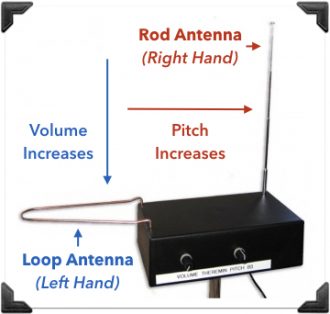
The theremin is controlled with two antennas.
- loop antenna – to control volume
- rod antenna – to control pitch
Typically, the right hand controls pitch, while the left controls volume. Although either way works fine.
- By moving your hand closer to the loop antenna, volume increases.
- By moving your hand closer to the rod antenna, pitch increases.
And it’s that simple. However, using this knowledge to actually create music is a different matter entirely.
So here are some simple examples of things you could do. You could:
- Use fluttering gestures with your volume hand to create a tremolo effect
- Do the same with your pitch hand to create a vibrato effect.
- Make a sweeping motion with your pitch hand to create spacey effects.
- Make a pecking motion with your volume hand to produce distinct notes.
After that, the possibilities are pretty much endless. Moving on…
The 5 Best Theremins Currently on the Market
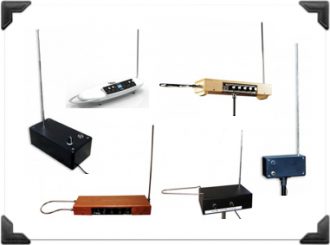
Now that you understand exactly what this instrument can do…
All that’s left now is to pick one out and start playing around with it.
So to help you with this part…I’ve made a list of 5 of the most popular theremin models on the market today.
Starting first with…
1. Moog Etherwave
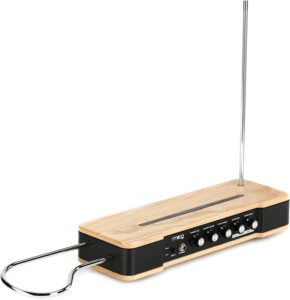
Next to Leon Theremin, Robert Moog is perhaps more responsible for the popularization of the theremin than anyone.
And today, Moog Music is undoubtedly the brand best known for making quality theremins.
Their brand new Etherwave model is a combination of their two former best selling models, the Etherwave Standard and Etherwave Plus.
Like the other theremins on this list, it comes equipped with the following standard features:
- 5 octave pitch range
- mic stand adapter
- power adapters for 110V and 220V
- 1/4″ line level output
Now, on top of these features it also has 2 pretty useful additional ones:
- Mute switch input to plug in a mute pedal
- CV (Control Voltage) inputs for controlling a synthesizer
Another unique feature of the Etherwave is its two knobs that allow you to control the waveform and brightness, on top of volume range, pitch range and headphone volume.
- Moog Etherwave – (Amazon/Sweetwater/Thomann)
And to see it in action, check out this video below:
Up next…
2. Moog ThereMINI
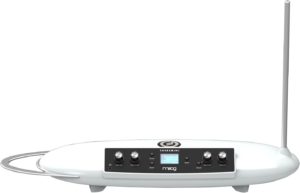
If you don’t need the synthesizer features of the previous theremin, you might be better off with this cheaper option instead: the Moog ThereMINI – (Amazon/Sweetwater/Thomann).
Compared to the previous analog model we just covered, you might call this the digital model.
Because its built-in sound engine adds a TON of useful features you might enjoy.
First, there’s a built-in tuner which gives you accurate feedback on the notes you’re playing in real-time. Which is a great tool for beginners learning the instrument and for anyone wanting to develop their ear.
Next there’s the outputs, which allow you 3 convenient ways to hear yourself play:
- a speaker on the top
- a headphone jack on the front
- two line level outs on the back
Next there’s the sound bank which allows your to store presets combinations of tones, scales, playing ranges, and effects.
One of the most useful effects worth noting is the stereo ping-pong delay. If you are a fan of Jimmy Page’s work, you may have noticed that delay is one of his go-to effects.
Finally, there’s the amazing feature known as assistive pitch quantization which you might refer to in simpler terms as…
Auto-Tune for the Theremin
Using a single setting, you can position this function anywhere between two extremes:
- At maximum position – every note in the specified scale will be perfectly in tune, making it impossible to play a wrong note…kinda like the Cher/T Pain effect.
- At minimum position – it’s essentially OFF, allowing you full control of the pitch, and full ability to mess things up as well. 🙂
For beginners, this tool can be especially useful because you can set it to give you just enough “help” to make things sound decent. And as you improve, you can gradually set it to give you less help until you no longer need any at all.
Up next…
3. Moog Claravox Centennial
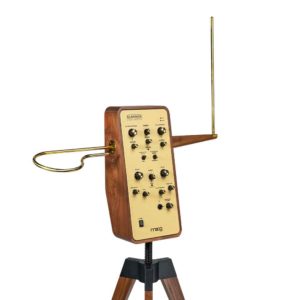
So you’ve probably noticed a trend in my theremin picks up until now, yes?
And it’s not because I’m biased to Moog. It’s only because there really aren’t a lot of other competitive theremin brands out there.
So for my final Moog pick, I’ve saved what you might consider the best of all: the Moog Centennial Claravox – (Amazon/Thomann).
This limited edition high-end theremin was created to celebrate the 100th anniversary of the instrument, as a tribute to virtuoso thereminist Clara Rockmore.
Personally I think it’s the most beautiful theremin of this list with its classic Moog panelboard and vintage look.
Apart from looks…this theremin is highly versatile, with a double analog and digital mode, which you can change with a switch.
With the digital mode is that you can assign your own scales, quantizations and more. Which is perfect for new players to help them find their notes more easily.
The CV outputs allow you to use the theremin as a controller for other analog synths, just like with the Etherwave.
With separate outputs for volume and pitch, the it allows you to connect those outputs to the inputs of an analog synthesizer such as the Moog Grandmother (Amazon/Sweetwater/Thomann) or Matriarch. (Amazon/Sweetwater/Thomann)
Check out this video to see it in action:
Up next…
4. Zep Theremin
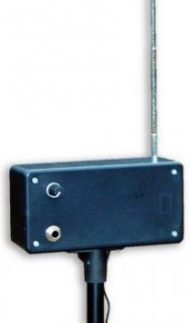
Now that we’ve thoroughly covered Moog Theremins…
Let’s move on to the NEXT most popular brand on the market: Burns Theremins.
And the first one I definitely recommend you check out is the Zep Theremin – (Amazon).
As you might guess from its name, it’s modeled after the one used by Jimmy Page in the iconic Led Zeppelin movie: The Song Remains the Same.
If you’ve watched this movie as many times as I have, you’re probably sold on this theremin already.
However, before you scroll down toward that Amazon link…hear me out first.
You see, the Zep Theremin, unlike the previous theremins we’ve seen, only has a single (pitch) antenna. Which is actually quite common on less expensive theremins.
The problem is, with no volume antenna, you can’t really play individual notes. So it’s really only good for making ‘bow-like’ continuous sounds.
Which is fine for making cool Jimmy-like effects. But NOT fine if you ever want to play one of those walking bass lines like in the video we saw earlier.
NOTE: As a work-around, you could pair these single antenna theremins with a volume pedal to get the same functionality as the more expensive two antenna models.
Up next…
3 More Burns Theremins
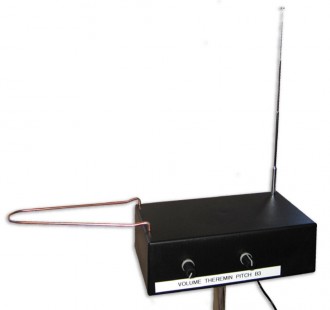
To finish out this post, there are 3 more Burns Theremins that are definitely worthy of mention.
The only problem is, as you’ll notice in their company product descriptions…their writers absolutely suck. aAnd they offer no real useful information on any features.
So for the most part, I was unable to find any juicy details on how these theremins compare with the others on this list.
Normally I would have taken these off the list entirely.
However with theremins, there really aren’t a whole lot of alternatives to choose from. And many people want cheaper options than the pricey Moog models.
PLUS…despite the lack of info on these guys, the user reviews on each of these theremins are still excellent. So definitely pay close attention to those.
Anyways, here they are:
- B3 Theremin – (Amazon)
- B3 Theremin Deluxe – (Amazon)
- “Great Sounding Theremin at a Great Price” – (Amazon)
Now, to conclude and as a bonus I’d like to mention one theremin that only works if you already have a modular synthetizer: the Doepfer A-178.
By the way, if you found this post useful, I highly recommend joining our free Home Recording Secrets email newsletter where you’ll discover….
- How to Get Your First Studio Up and Running in a Single Weekend
- How to Avoid Wasting Thousands of Dollars on Unnecessary Pointless Purchases
- How to Get a “Million Dollar” Pro Studio Sound in a “Thousand Dollar” Home Studio
- PLUS… All Sorts of Other Amazing Insider Secrets Revealed
And it’s totally FREE! Click here and Enter Your Email to Sign Up.
More Guitar Posts in This Series:
Electric Guitar | Acoustic Guitar | Bass Guitar | Amps | Pedals | Cables | Pickups | Bass Strings | Bass Amps | Bass Pickups | Classical Guitars | Acoustic Pickups | Direct Boxes | Cases | Picks | Slides | Straps | Tuners | Stands | Strings | Capos | Tabs | Guitar Accessories